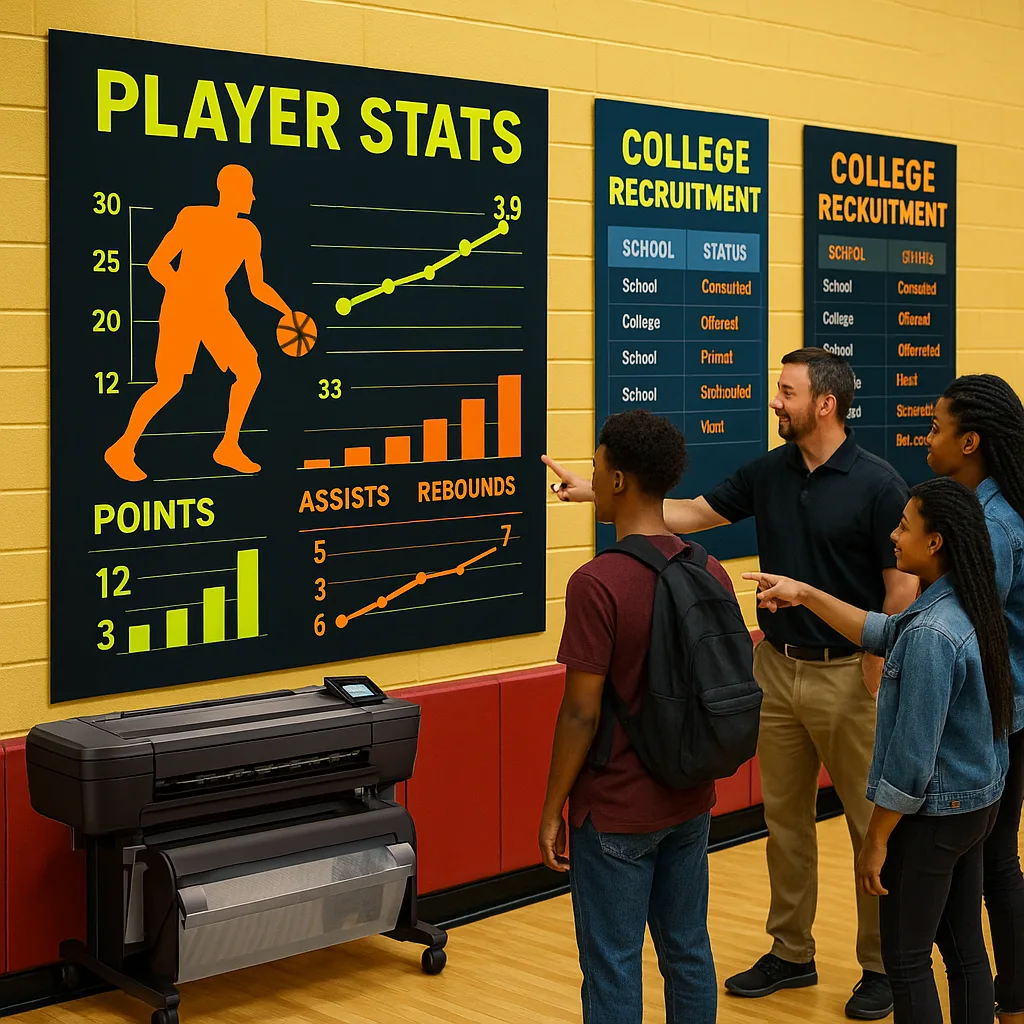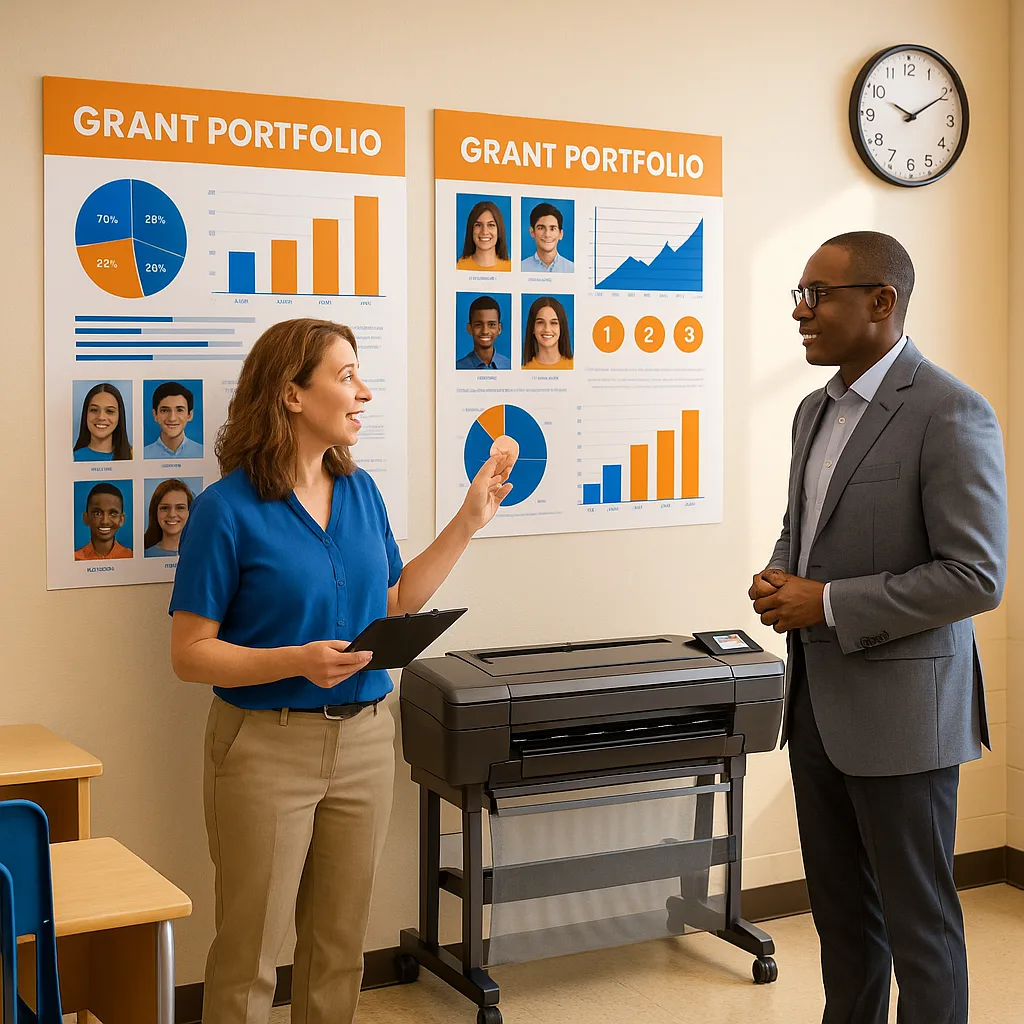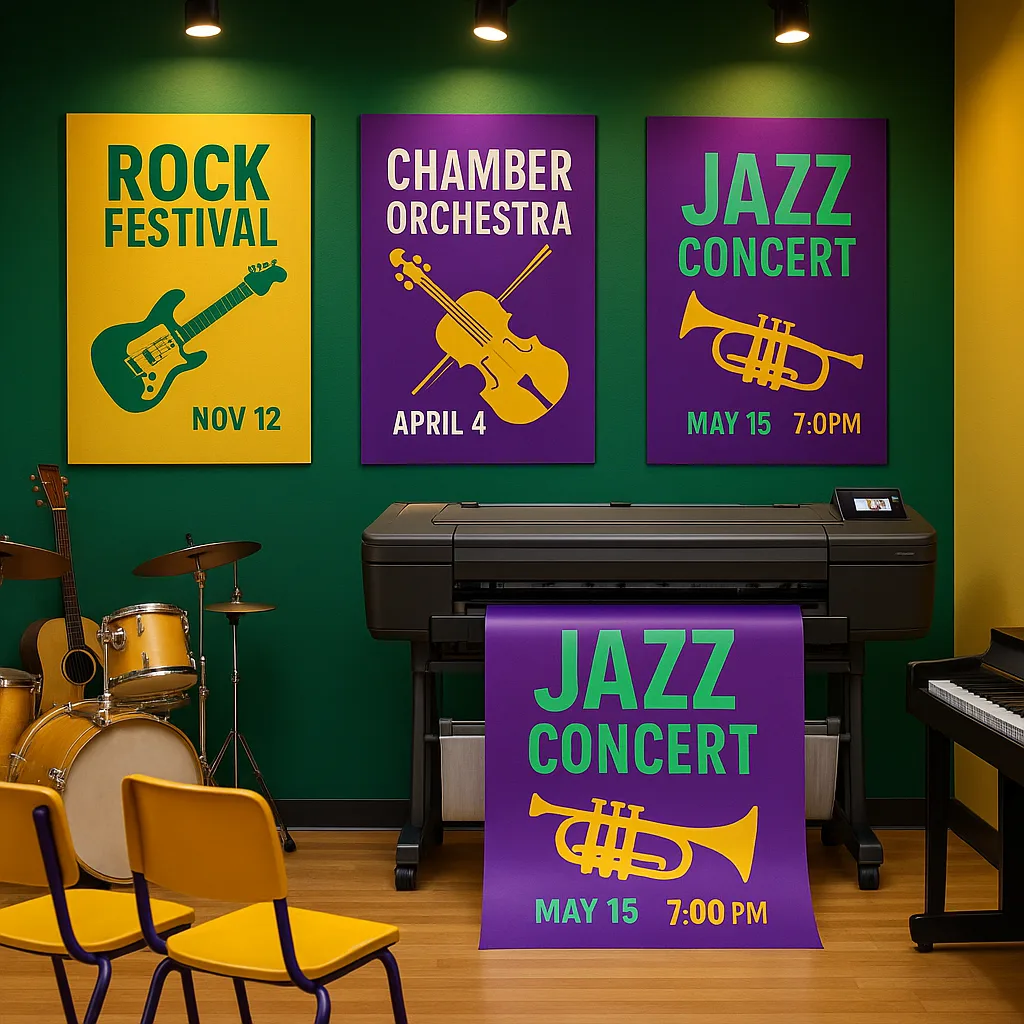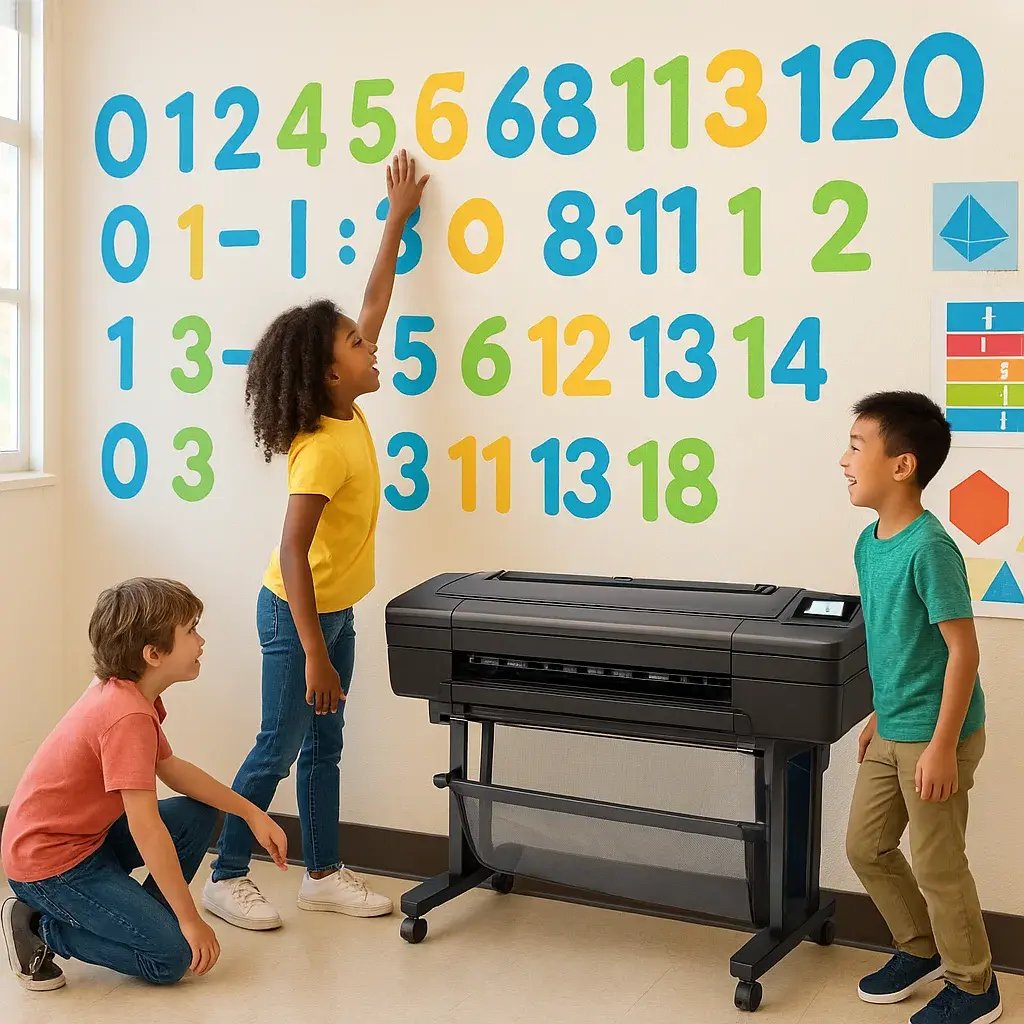
Best Poster Maker Machine for Interactive Math Walls
Have you ever watched a first-grader physically walk along a giant number line on your classroom floor? Their faces light up as they hop from 5 to 8, counting each jump out loud. This is the magic of kinesthetic learning in action, and with the best poster maker machine kinesthetic math tools, you can transform every wall in your classroom into an interactive mathematical playground that gets kids moving, touching, and truly understanding math concepts.
“Why Movement Matters in Math”
According to research from the Edutopia Foundation, movement activates multiple brain regions simultaneously, improving memory retention by up to 77% compared to seated learning alone. When students physically interact with math concepts, they’re not just memorizing—they’re embodying the learning.
Creating Your Interactive Math Wall with the Best Poster Maker Machine Kinesthetic Math Tools
The first time I created a wall-mounted fraction bar in my classroom, I used construction paper and spent hours cutting and laminating. Now, with our Education Flex 30 Poster Printer Cutter Package B, I can design, print, and cut an entire interactive math wall in under an hour. The print-and-cut technology means each piece is perfectly sized, durable, and ready for hundreds of little hands to explore.
When considering the poster machine price for your classroom transformation, think about the time you’ll save and the engagement you’ll gain. Most teachers report recouping their investment within the first semester through reduced prep time alone. Plus, with our 5-year warranty, you’re covered for your entire elementary teaching journey.
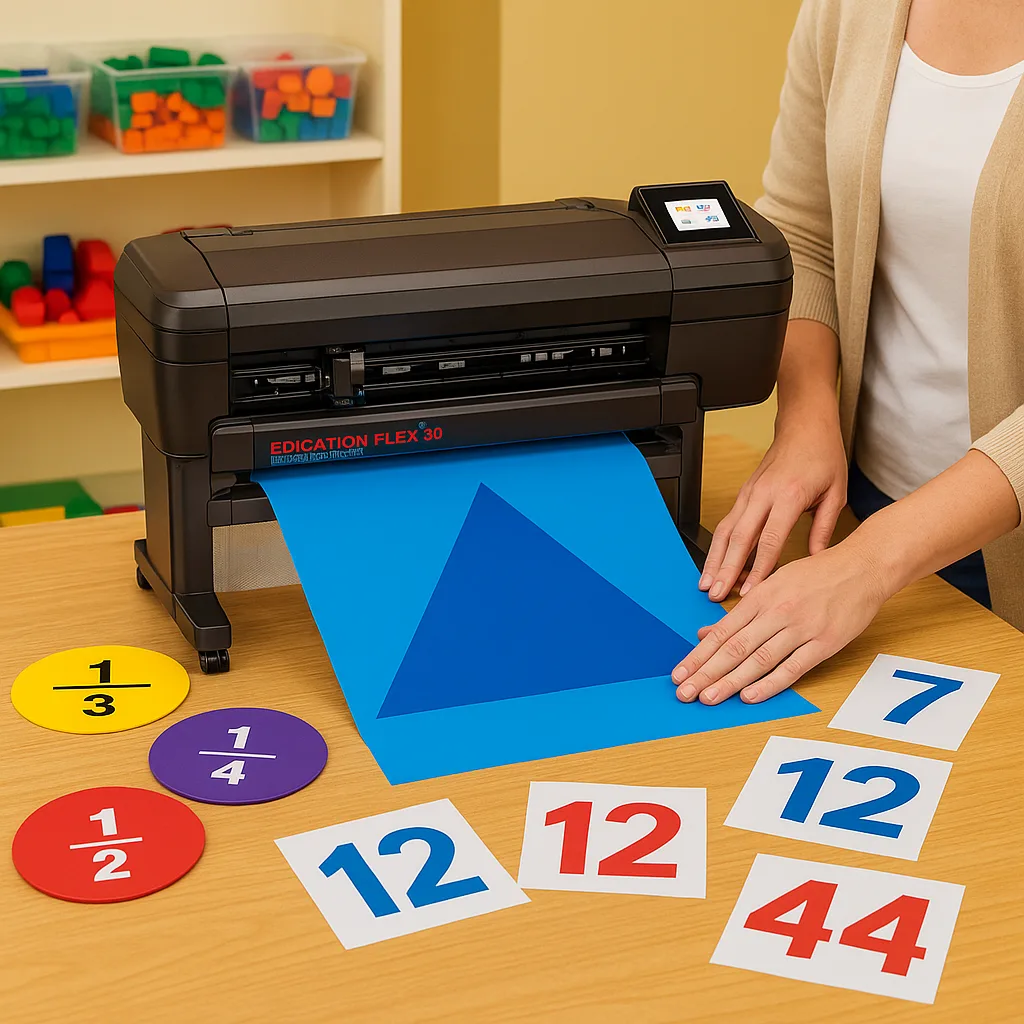
Essential Components for Movement-Based Math Learning
Let me share what’s working in classrooms across the country. Teachers using kinesthetic math walls report a 40% increase in student participation during math lessons, according to a National Council of Teachers of Mathematics study.
Here’s what you’ll want to include:
Giant Number Lines (Floor to Ceiling)
Print 8-inch number cards from 0-100 (or -20 to 20 for older grades) and mount them vertically. Students physically reach up or bend down to show greater than/less than relationships. I’ve seen shy students suddenly volunteer when they get to use their whole bodies to demonstrate concepts.
Fraction Walls That Students Can Rearrange
Using repositionable vinyl from our Education Flex 20 Package, create fraction pieces that students can physically move and compare. Yesterday, one of my kinesthetic learners finally understood equivalent fractions by physically placing 2/4 next to 1/2 on our wall.
Place Value Charts with Pockets
Print large place value charts and add clear pockets (we use the affordable ones from Dollar Tree). Students walk up and physically place number cards in the correct columns. The movement reinforces place value understanding far better than worksheets ever could.
Best Poster Maker Machine Kinesthetic Math: Design Templates That Work
Through trial and error (and lots of happy accidents), I’ve developed templates that maximize engagement while minimizing prep time. With our lifetime design service, you don’t even need to create these yourself—our team can customize any of these ideas for your specific needs.
The Walk-the-Line Multiplication Mat
This 36″ x 72″ floor mat has been a game-changer in my classroom. Students literally walk through multiplication problems, stepping on factors and leaping to products. One second-grade teacher in Georgia told me her students beg to practice times tables now. The Education Studio 36″ Package A+ prints these mats on durable, water-resistant material that handles daily foot traffic.
Design specifications:
– Grid layout with 12×12 multiplication table
– 6-inch squares for each number
– Color-coded by factor families
– Arrows showing multiplication pathways
– Anti-slip backing for safety
Geometric Shape Exploration Wall
Transform a 10-foot wall section into an interactive geometry center. Print large shapes that students can trace with their fingers, measure with their arm spans, and even dance around to understand perimeter.
Include these elements:
– 2D shapes from 12″ to 36″ wide
– 3D shape nets that students can visualize folding
– Angle measurement guides at student height
– Symmetry exploration mirrors (apply reflective vinyl strips)
– Real-world shape connections (stop signs, pizza slices, etc.)
The Human Calculator Wall
This is where technology meets movement brilliantly. Using QR codes printed alongside math problems, students scan with tablets, solve mentally, then physically move to touch the answer on the wall. It combines digital engagement with physical movement—perfect for today’s learners.
Addressing Different Learning Styles with Interactive Math Walls
Not every kinesthetic learner moves the same way. Through Universal Design for Learning principles, I’ve learned to create math walls that accommodate various movement preferences and abilities.
For Large Movement Learners:
Create floor-to-ceiling number lines where students can jump, stretch, and reach. Print numbers on our Adhesive Wall and Floor Signage Vinyl for durability. These learners need whole-body engagement to process mathematical concepts effectively.
For Fine Motor Learners:
Design walls with removable pieces that require precise placement. Fraction bars with Velcro backing, place value cards in pockets, and geometric shapes that fit together like puzzles work beautifully. The precision required helps these learners focus while still incorporating movement.
For Collaborative Movers:
Some kinesthetic learners process best through social movement. Create math walls designed for partner work—think giant hundreds charts where two students work together to find number patterns, or measurement walls where pairs can compare their arm spans to standard units.
Budget-Conscious Implementation: Making Every Dollar Count
When I share these ideas at conferences, the first question is always about cost. Here’s the truth: the poster machine price becomes negligible when you consider the long-term savings and impact. Let me break down the economics that convinced my principal.
Initial Investment vs. Long-Term Savings
Traditional math manipulatives for a classroom set: $500-800 annually
Wall-mounted alternatives created with poster maker: $50-75 in materials
Time saved on prep: 10+ hours per unit
Durability: 3-5 years vs. 1 year for traditional manipulatives
Our cost per print calculator shows that large math walls cost approximately $1.50 per square foot to produce. Compare that to commercial educational posters at $30-50 each, and you’ll see why schools are making the switch.
Funding Your Kinesthetic Math Revolution
Title I schools have particularly embraced these tools. Using math achievement gap data, many have justified the purchase through federal funding. Our team at 866-788-7900 can help you write grant proposals that highlight the research-backed benefits of movement-based learning.
Consider these funding sources:
– Title I mathematics improvement funds
– STEM education grants
– Parent-teacher organization fundraisers
– Community partnership donations
– District professional development budgets
Real Classroom Success Stories
Let me share what’s happening in real classrooms using these techniques. Mrs. Rodriguez in New Mexico transformed her third-grade math scores using wall-mounted manipulatives. “My ELL students especially benefit,” she told me. “When language is a barrier, movement becomes the universal communicator.”
Using her Education Express 36 Poster Printer, she created:
– Bilingual number lines with visual cues
– Fraction walls with real-food images
– Measurement charts using familiar objects
– Word problem stations with moveable parts
Her math proficiency scores jumped 23% in one year. More importantly, her students now say math is their favorite subject.
The Unexpected Benefits
Beyond test scores, teachers report improvements in:
– Classroom community (students help each other at math walls)
– Physical fitness (math becomes active time)
– Attention spans (movement breaks are built into lessons)
– Creative thinking (students suggest new wall activities)
– Parent engagement (families love seeing interactive displays)
Technical Tips for Durable, Safe Math Walls
After three years of creating these walls, I’ve learned what works and what doesn’t. Here’s my hard-won wisdom:
Material Selection Matters
For high-touch areas, use our Heavyweight Coated Paper with lamination. For floor applications, only use certified non-slip materials. Safety always comes first.
Installation Best Practices
Mount materials at three heights:
– Floor level (0-24″): Sitting/kneeling activities
– Mid-level (24-48″): Standing activities
– Reach level (48-72″): Stretching/jumping activities
Maintenance Routines
Create a “Math Wall Monitor” classroom job. Students check for loose pieces, clean surfaces, and report wear. This ownership increases respect for the materials and provides additional learning opportunities.
Designing for Special Needs and Accessibility
Every learner deserves access to movement-based math learning. Working with our special education team, I’ve developed modifications that ensure inclusion:
For Wheelchair Users:
– Create horizontal number lines at desk height
– Design reach-accessible fraction walls
– Use extending pointers for high elements
– Incorporate lap-sized versions of wall activities
For Sensory-Sensitive Students:
– Choose calming colors (blues and greens)
– Avoid overwhelming patterns
– Create quiet zones within math walls
– Offer textile variations (felt numbers for tactile seekers)
For Visual Processing Challenges:
– High contrast between numbers and backgrounds
– Consistent color coding across concepts
– Large, clear fonts (minimum 3-inch height)
– Tactile elements to supplement visual information
Assessment Strategies for Movement-Based Math
How do you grade jumping? It’s a question I get often. Assessment in kinesthetic math environments requires creativity, but the insights gained are invaluable.
Observational Rubrics
Create simple check sheets noting:
– Accuracy of physical demonstrations
– Explanation during movement
– Peer collaboration quality
– Problem-solving approaches
– Self-correction behaviors
Video Documentation
With parent permission, record students explaining concepts at math walls. These videos become powerful portfolio pieces showing growth over time. Students love watching themselves teach math concepts through movement.
Student Self-Assessment
Provide reflection sheets asking:
– Which wall activity helped you understand best?
– What movement made the math “click”?
– How would you teach this to a younger student?
– What new wall activity could we create?
Getting Started: Your First Week with Kinesthetic Math Walls
Ready to transform your classroom? Here’s your week-one roadmap:
Monday: Introduce one simple element (a 0-20 number line)
Tuesday: Model how to use it with whole-class activities
Wednesday: Partner practice with guided support
Thursday: Independent exploration with observation
Friday: Student-created problems using the wall
Start small. Even one interactive element changes the classroom dynamic. As students become comfortable, add new components weekly.
The Future of Math Education
As I watch my first-graders confidently navigate fraction relationships by physically moving pieces on our math wall, I know we’re onto something special. The combination of movement, visual learning, and tactile engagement addresses how young brains naturally learn mathematical concepts.
The best poster maker machine kinesthetic math tools aren’t just about pretty walls—they’re about fundamentally changing how children experience mathematics. When we honor the connection between movement and learning, we unlock potential that worksheets alone could never reach.
Educational research consistently shows that active learning environments produce deeper understanding and longer retention. By investing in the right tools and embracing movement-based instruction, we’re not just teaching math—we’re creating mathematicians who think with their whole bodies.
Ready to Create Your Interactive Math Classroom?
Download our complete guide with 25+ math wall templates, funding resources, and implementation timeline. Transform your teaching and watch your students leap (literally!) into mathematical understanding.
Have questions about creating your kinesthetic math walls? Call our education specialists at 866-788-7900 or explore our demo video to see these tools in action.




